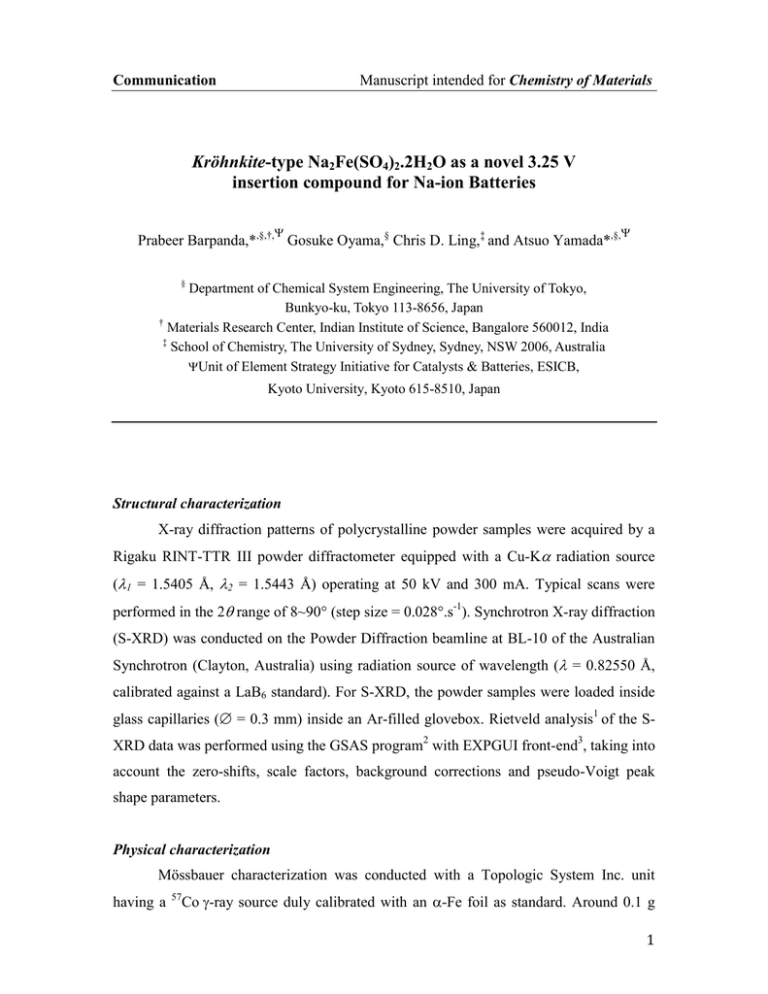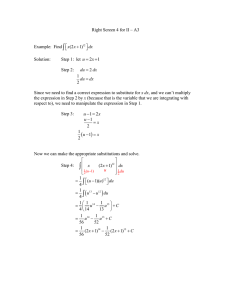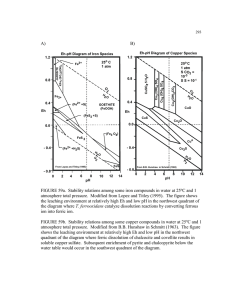Fe(SO ) .2H
advertisement

Communication Manuscript intended for Chemistry of Materials Kröhnkite-type Na2Fe(SO4)2.2H2O as a novel 3.25 V insertion compound for Na-ion Batteries Prabeer Barpanda,*,§,†, Gosuke Oyama,§ Chris D. Ling,‡ and Atsuo Yamada*,§, § Department of Chemical System Engineering, The University of Tokyo, Bunkyo-ku, Tokyo 113-8656, Japan † Materials Research Center, Indian Institute of Science, Bangalore 560012, India ‡ School of Chemistry, The University of Sydney, Sydney, NSW 2006, Australia Unit of Element Strategy Initiative for Catalysts & Batteries, ESICB, Kyoto University, Kyoto 615-8510, Japan Structural characterization X-ray diffraction patterns of polycrystalline powder samples were acquired by a Rigaku RINT-TTR III powder diffractometer equipped with a Cu-K radiation source (1 = 1.5405 Å, 2 = 1.5443 Å) operating at 50 kV and 300 mA. Typical scans were performed in the 2 range of 8~90 (step size = 0.028.s-1). Synchrotron X-ray diffraction (S-XRD) was conducted on the Powder Diffraction beamline at BL-10 of the Australian Synchrotron (Clayton, Australia) using radiation source of wavelength ( = 0.82550 Å, calibrated against a LaB6 standard). For S-XRD, the powder samples were loaded inside glass capillaries ( = 0.3 mm) inside an Ar-filled glovebox. Rietveld analysis1 of the SXRD data was performed using the GSAS program2 with EXPGUI front-end3, taking into account the zero-shifts, scale factors, background corrections and pseudo-Voigt peak shape parameters. Physical characterization Mössbauer characterization was conducted with a Topologic System Inc. unit having a 57 Co-ray source duly calibrated with an -Fe foil as standard. Around 0.1 g 1 powder sample was sealed inside a Pb sample holder by polyethylene films. The spectra were collected for over 10 h in transmission mode and were fitted by MossWinn3.0 program. Infrared spectra were acquired using KBr pellets containing powder samples in the wavelength range of 400 ~ 4000 cm-1with a JASCO FT/IT-6300 unit. Thermal analysis was performed in RT ~ 500 C temperature range (heating rate = 5 C.min-1) with a Rigaku ThermoPlus DSC 8230 unit operating under steady Ar flow. Scanning electron microscopy was conducted on powder samples mounted on conducting carbon tape by a Hitachi S-4800 FE-SEM unit operating at 5 kV. Electrochemical characterization To gauge the feasibility of Na (de)insertion, the working electrode was formulated by mixing 80 wt% active material Na2Fe(SO4)2.2H2O, 15 wt% acetylene carbon black and 5 wt% of polyvinylidene fluoride (PVdF) binder in NMP (N-methylpyrrolidone) solvent. The resulting slurry was cast on an Al film acting as current collector. Post overnight drying at 120 C in vacuum, 20 m thick cathode disks ( = 18 mm) were punched out with a average cathode loading of ~3 mg.cm-2. 2032-type coin cells were assembled inside an Ar-filled glove box using these cathode disks as working (+ve) electrodes, Na metal foil as counter (-ve) electrodes separated by polypropylene films soaked with 1 M NaClO4 dissolved in propylene carbonate (PC) acting as electrolyte. These coin cells were subjected to galvanostatic cycling with a TOSCAT-3100 battery tester (Toyo system) in the voltage range of 2.0-4.0 V (at 25 C). References 1. Rietveld, H. M. J. Appl. Crystallogr.1969, 2, 65-71. 2. Larson, A. C.; Von Dreele, R. B. General Structure Analysis System (GSAS); Los Alamos National Laboratory Report, LAUR 86-748: Los Alamos National Laboratory: Los Alamos, NM, 1994. 3. Toby, B. H. J. Appl. Crystallogr.2001, 34, 210-213. 2 Figure S1: FT-IR spectrum of Na2Fe(SO4)2.2H2O phase depicting the vibration bands corresponding to constituent SO4 and H2O units. The constituent bonded and free SO42- anions delivers several IR peaks in the low wavenumber window (400-1700 cm-1) (Figure S1). The asymmetric SO4 tetrahedra further leads to degeneration in these principal IR peaks. Four main internal modes are observed, which can be described as: (a)the symmetric stretching mode 1, (b)the symmetric bending mode 2, (c)the asymmetric stretching mode 3, and (d)the asymmetric bending mode 4. Owing to the overall asymmetry in SO4 arrangement, the asymmetric stretching and bending mode (3 and 4) undergo severe degeneration leading to multiple bands around 1105 cm-1 and 611 cm-1. Additionally, broad and distinct peak at high wavenumber window (3200-3600 cm-1) is observed arising from the symmetric/ asymmetric stretching of OH- anions of the structural H2O component. 3 Figure S2: Representative SEM image of as-synthesized Na2Fe(SO4)2.2H2O compound showing micrometric (secondary) agglomerates consisting of primary nanoparticle of size range 100-300 nm. Figure S3: Differential (dQ/dV) curve of charge-discharge profile of Na2Fe(SO4)2.2H2O krohnkite phase. The average redox potential is centered around 3.25 V. 4 Figure S4: Thermal analyses (TG-DTA) profiles of Na2Fe(SO4)2.2H2O krohnkite phase. The dehydration occurs in multiple steps between 170-300 C. The final product was Na6Fe(SO4)4. Figure S5: Charge-discharge profile of Na6Fe(SO4)4 phase showing 3.4 V redox activity. 5



